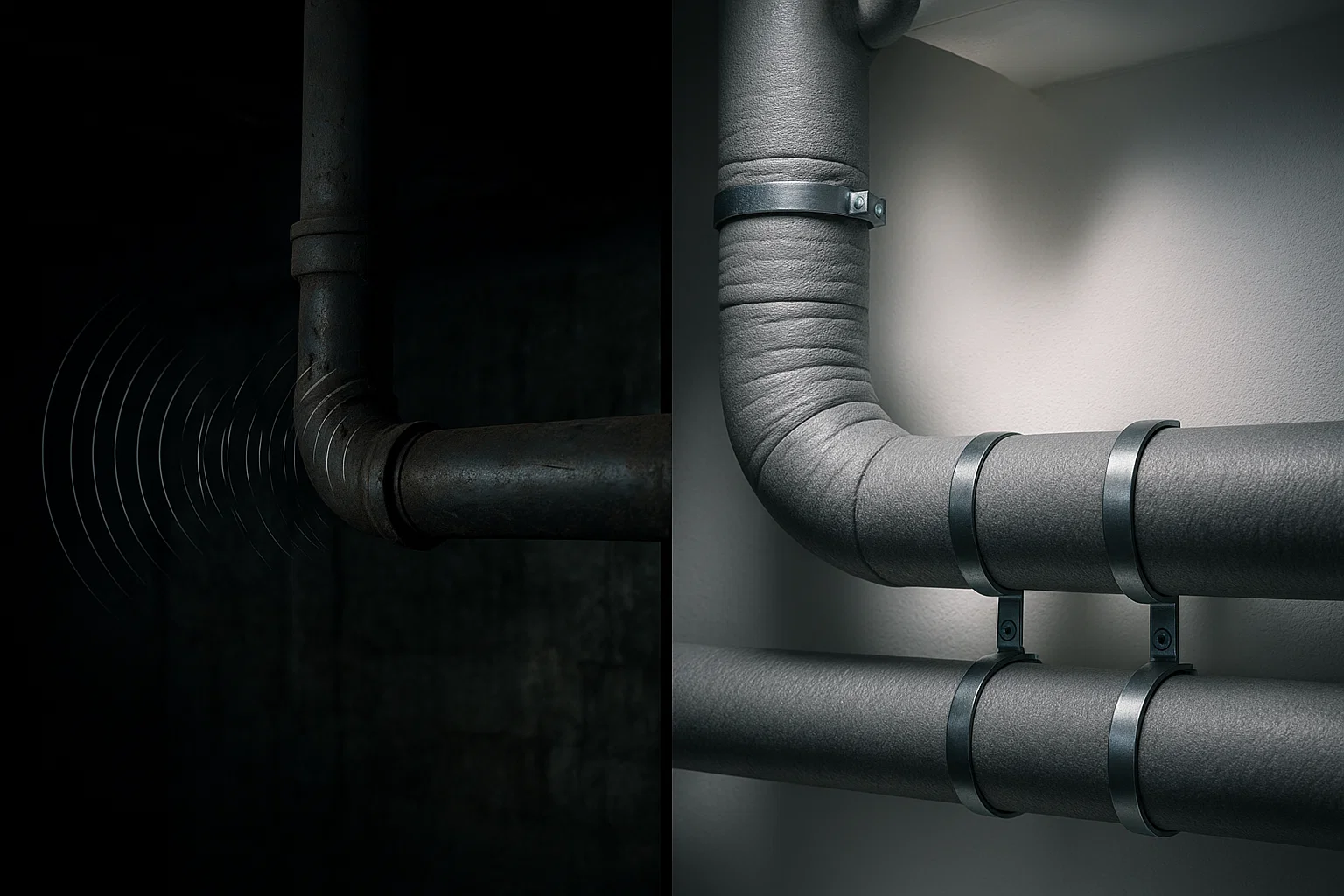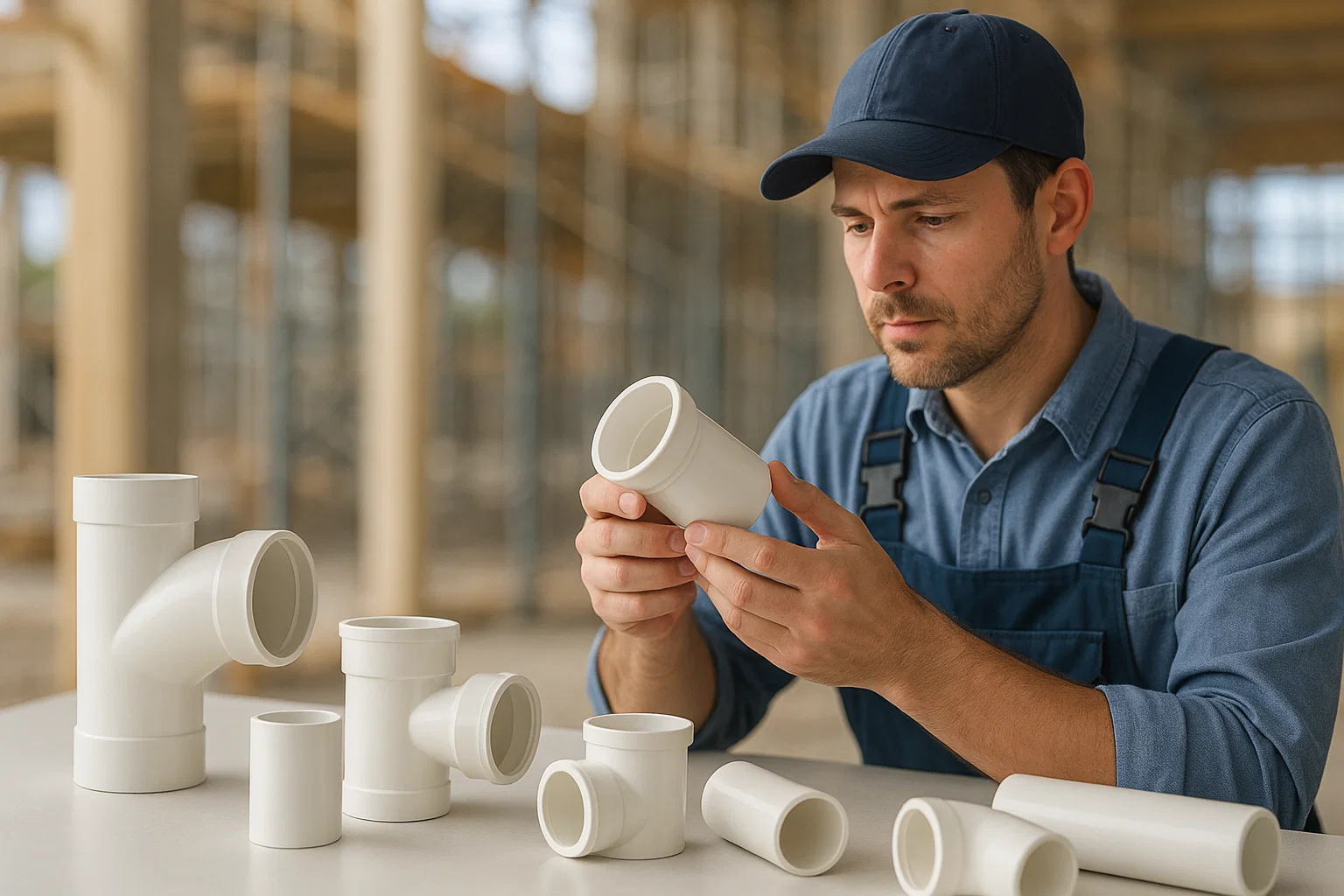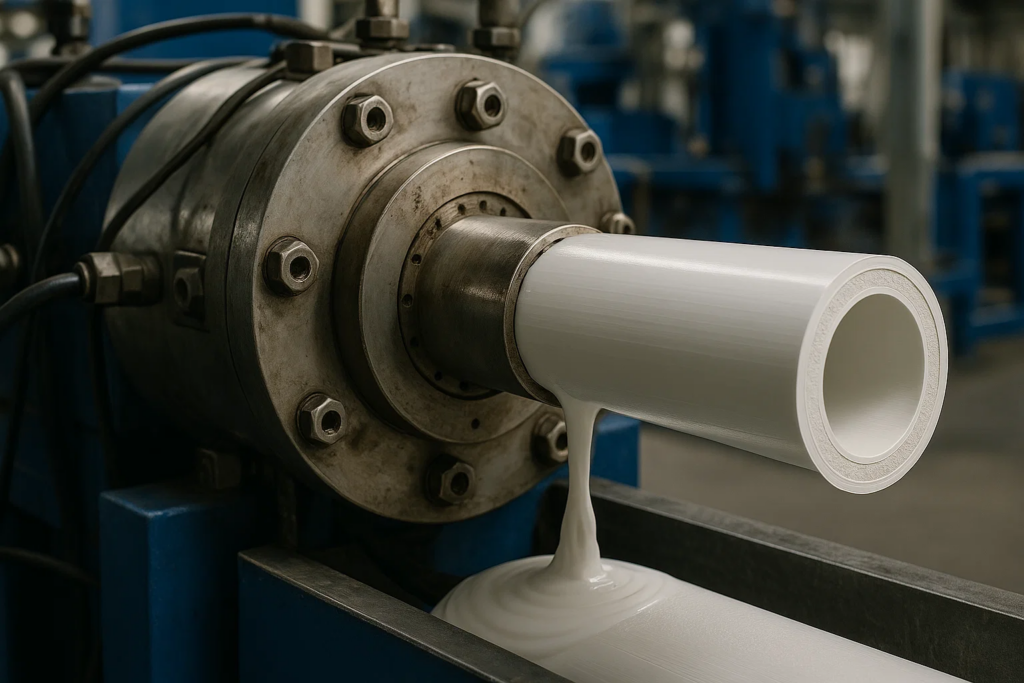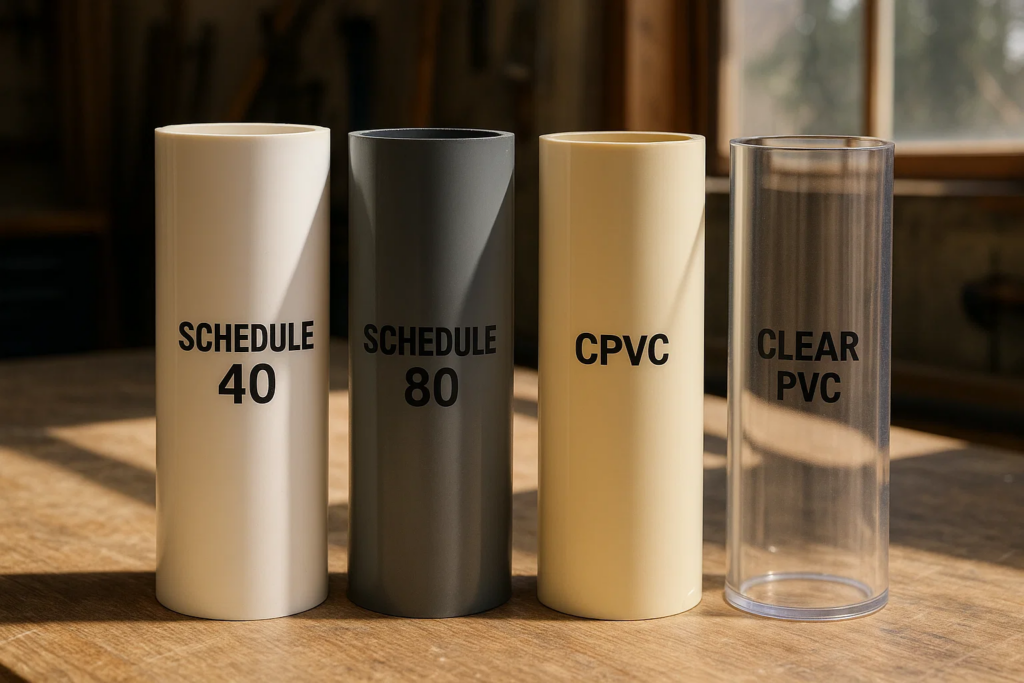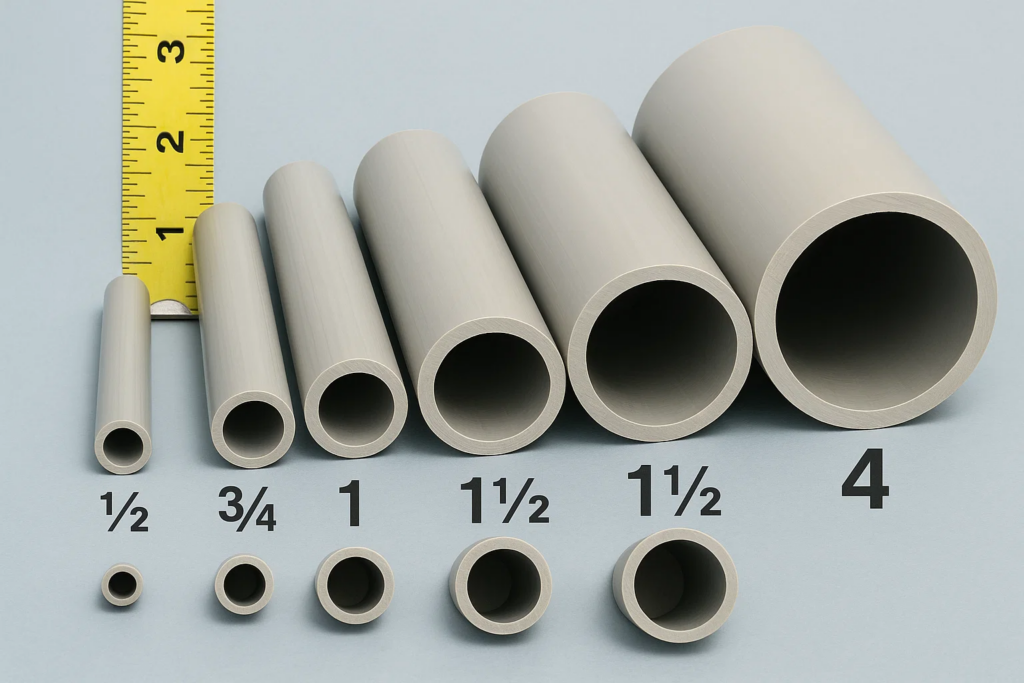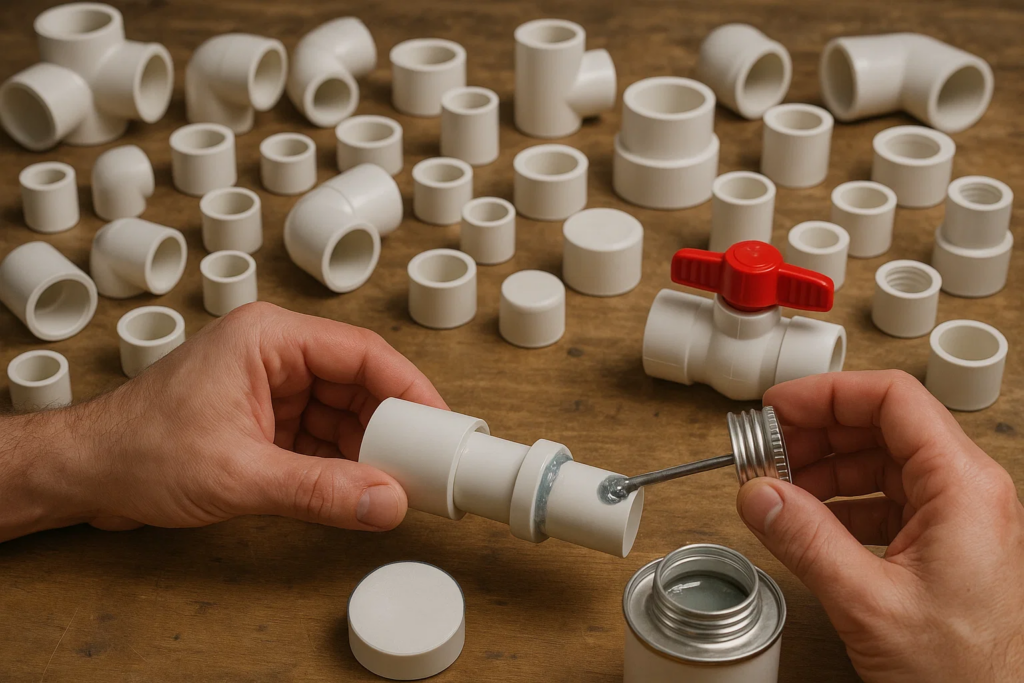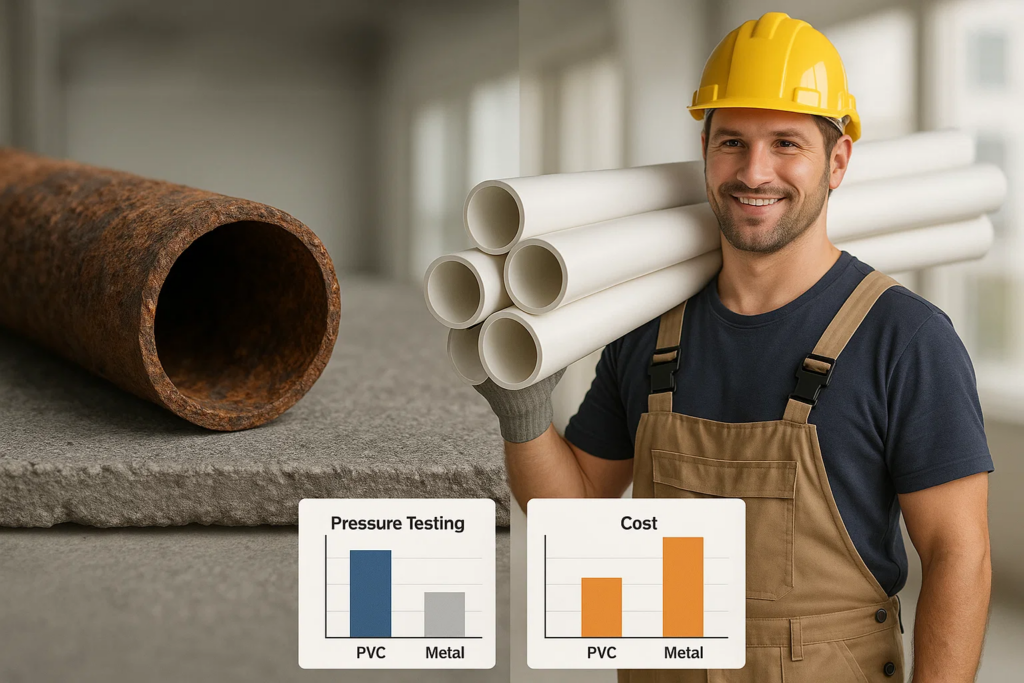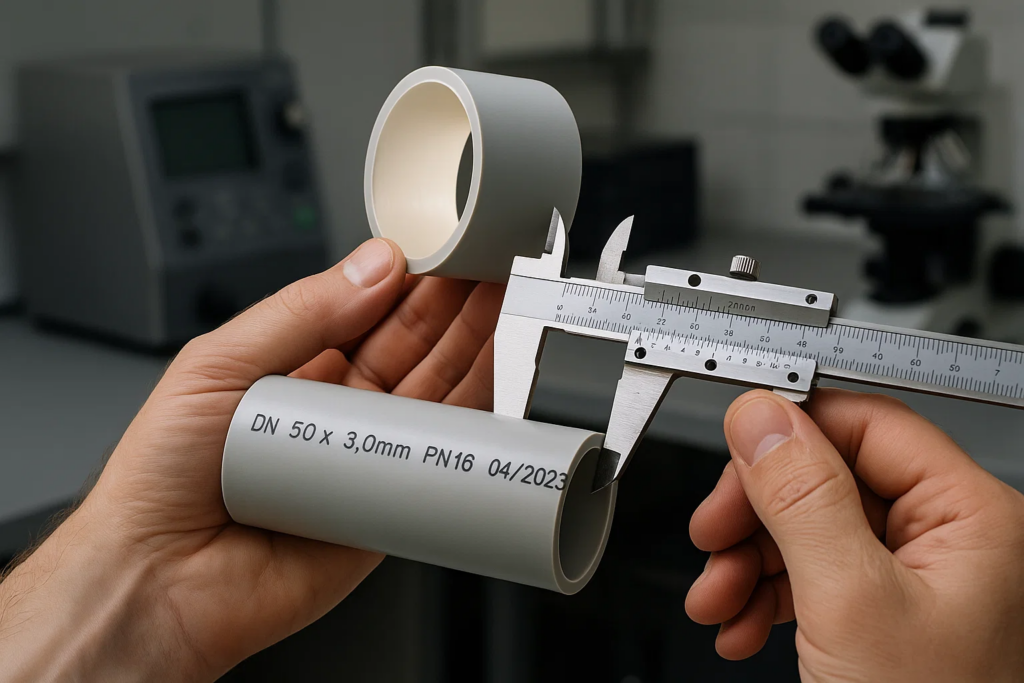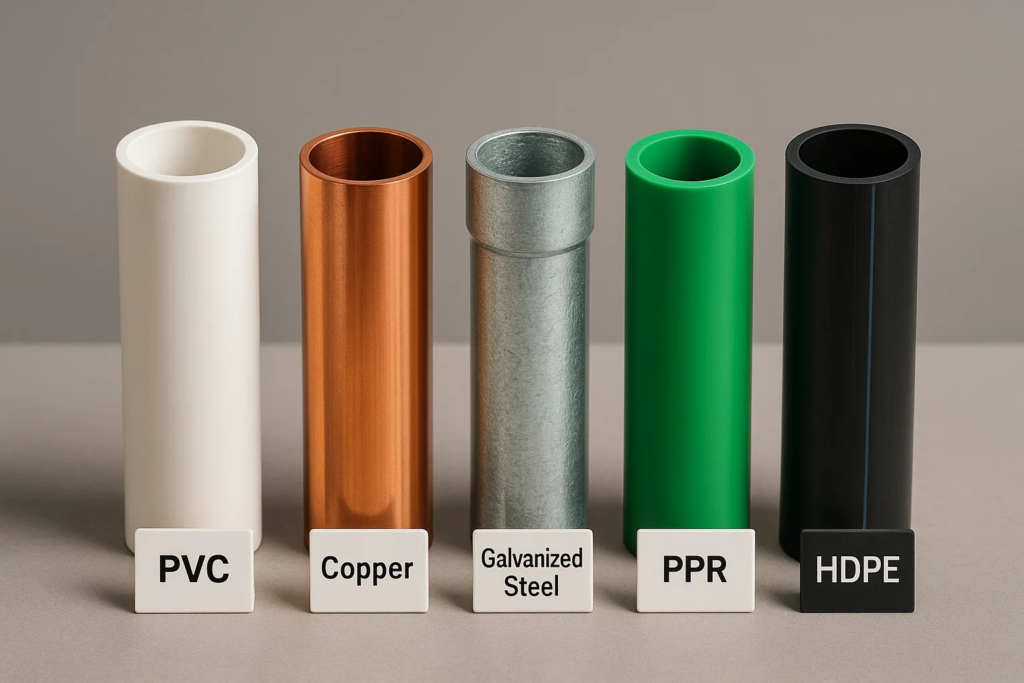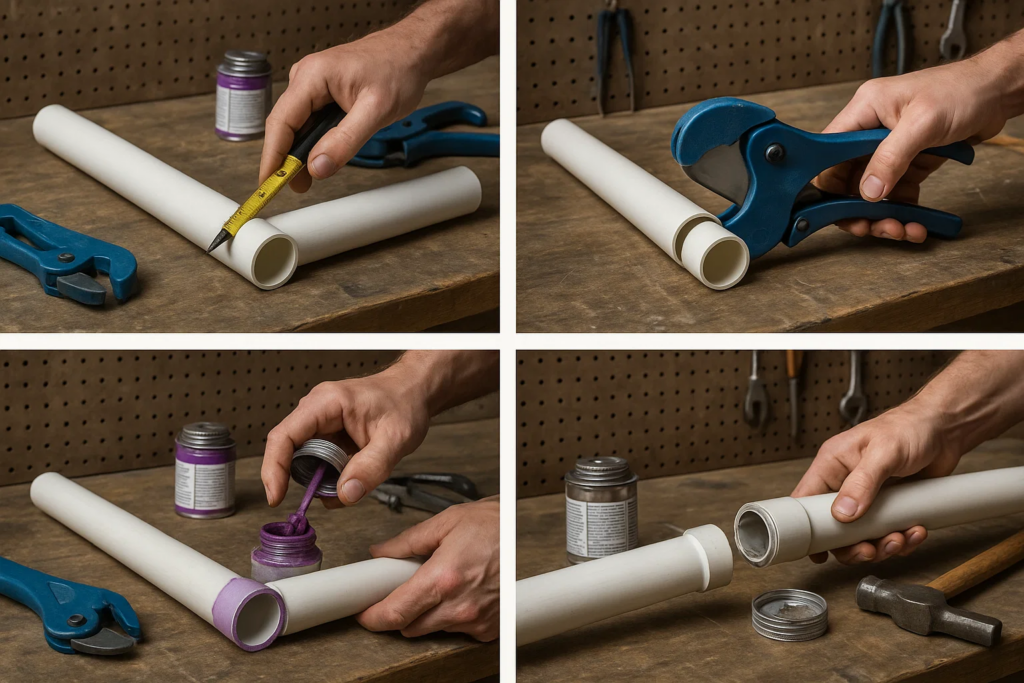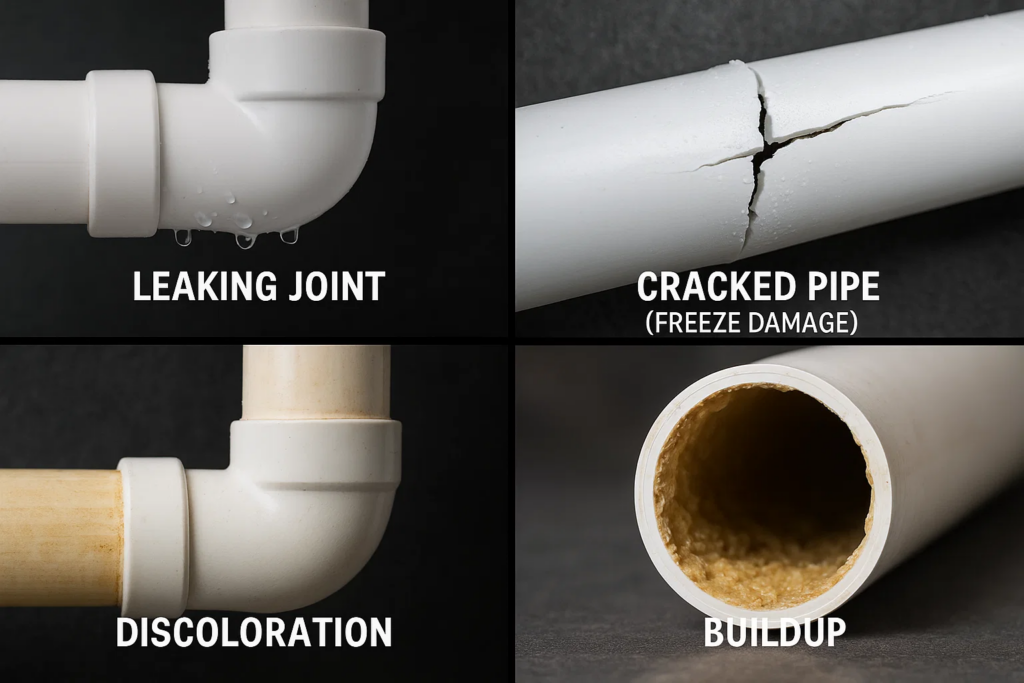Introduction to PVC Pipes
Are you frustrated with corroded metal pipes that contaminate your water or struggling with expensive plumbing materials that quickly deteriorate? Neglecting to choose the right piping material can lead to costly repairs, water contamination, and recurring maintenance issues. Fortunately, PVC pipes offer a versatile, cost-effective solution that has revolutionized modern plumbing and construction industries.
PVC (Polyvinyl Chloride) pipe is a plastic tubing system widely used for plumbing, drainage, irrigation, and numerous other applications. Since its commercial introduction in the 1930s, PVC has become one of the most widely used piping materials worldwide due to its durability, versatility, and cost-effectiveness.
What are PVC Pipes Made Of?
Understanding PVC pipes begins with knowing their composition. PVC pipes are manufactured from polyvinyl chloride, a synthetic plastic polymer created through the polymerization of vinyl chloride monomer (VCM). The production process involves several key stages:
- Polymerization: Vinyl chloride monomers undergo polymerization to form PVC resin.
- Compounding: The raw PVC resin is mixed with various additives, including:
- Stabilizers to prevent degradation from heat and UV light
- Plasticizers to increase flexibility (for flexible PVC)
- Pigments for coloration (typically white or gray for plumbing applications)
- Impact modifiers to improve strength
- Lubricants to enhance processing
- Extrusion: The compounded PVC mixture is heated and forced through an extruder to form the pipe shape.
- Cooling and Cutting: The extruded pipe is cooled in water baths and cut to standard lengths.
The final composition typically consists of about 80-85% PVC resin and 15-20% additives, though the exact formulation varies depending on the intended application and required properties.
Types of PVC Pipes
The world of PVC pipes encompasses several variations, each designed for specific applications and conditions. Here are the primary types you should know about:
Schedule-Based Classification
PVC pipes are commonly classified by “schedule,” which refers to their wall thickness:
- Schedule 40 PVC: The standard white PVC pipe used for most residential plumbing applications. It has a moderate wall thickness and is suitable for water supply lines, drain systems, and irrigation.
- Schedule 80 PVC: Featuring thicker walls than Schedule 40, these pipes (often gray or dark gray) are designed for high-pressure applications, industrial uses, and situations requiring extra durability. They have a smaller inside diameter due to the thicker walls.
Application-Based Classification
- PVC-U (Unplasticized PVC): Also known as rigid PVC, this is the most common type used for plumbing and water distribution. UPVC pipes are known for their rigidity and strength.
- PVC-O (Oriented PVC): Created through a molecular orientation process that enhances strength and impact resistance while reducing wall thickness.
- CPVC (Chlorinated PVC): Contains extra chlorine and can withstand higher temperatures (up to 200°F/93°C), making it suitable for hot water applications. Understanding the difference between UPVC and CPVC pipes is crucial for proper application.
- High-Pressure PVC: Specially designed to handle elevated pressure levels in industrial and municipal applications. PVC high-pressure valves are essential components in these systems.
Each type serves different purposes, and selecting the right one depends on factors such as pressure requirements, temperature conditions, and chemical exposure.
Common PVC Pipe Sizes and Specifications
PVC pipes come in a variety of standard sizes to accommodate different applications:
Nominal Pipe Sizes (NPS)
The most common residential PVC pipe sizes include:
- 1/2 inch (15 mm)
- 3/4 inch (20 mm)
- 1 inch (25 mm)
- 1 1/2 inches (40 mm)
- 2 inches (50 mm)
- 3 inches (75 mm)
- 4 inches (100 mm)
For larger commercial and industrial applications, sizes can range up to 24 inches (600 mm) or more.
Pressure Ratings
PVC pipes are also classified by their pressure ratings, typically measured in pounds per square inch (psi) or bar:
- Class 100 (100 psi)
- Class 160 (160 psi)
- Class 200 (200 psi)
- Class 315 (315 psi)
Understanding the difference between PN10 and PN16 pressure ratings is important when selecting pipes for specific applications.
Length Standards
Most PVC pipes come in standard lengths of:
- 10 feet (3 meters)
- 20 feet (6 meters)
These standardized dimensions ensure compatibility across different manufacturers and applications.
PVC Pipe Fittings and Connections
A comprehensive PVC pipe guide wouldn’t be complete without discussing the various fittings and connection methods that make this system so versatile:
Common PVC Fittings
- Couplings: Connect two pipes of the same diameter
- Elbows: Create 45° or 90° turns in the piping system
- Tees: Create three-way connections
- Wyes: Y-shaped fittings for drainage applications
- Reducers: Connect pipes of different diameters
- Caps and Plugs: Seal the end of a pipe or fitting
- Adapters: Transition between different materials or connection types
- Valves: Control the flow of liquids (gate valves, ball valves, check valves)
Connection Methods
- Solvent Welding: The most common method for connecting PVC pipes, using PVC primer and cement to create a chemical bond. Knowing how to remove PVC pipe glue can be helpful during modifications or repairs.
- Threaded Connections: Some PVC fittings have threads for mechanical connections, particularly when transitioning to other materials. Understanding thread sizes is essential for proper connections.
- Compression Fittings: Use mechanical pressure to create a watertight seal without adhesives.
- Push-Fit Connections: Allow for quick connections without solvent cement, using rubber O-rings for sealing.
- Flanged Connections: Used for larger diameter pipes, especially in industrial applications.
Proper connection technique is crucial for preventing leaks. For solvent welding, this includes proper preparation, application of primer and cement, and allowing adequate curing time.
Applications and Uses of PVC Pipes
The versatility of PVC pipes has led to their adoption across numerous industries and applications:
Plumbing and Water Supply
- Residential plumbing: Used for water distribution systems, drain lines, and vent pipes
- Municipal water distribution: For delivering clean water to homes and businesses
- Well water systems: Connecting wells to homes and irrigation systems
Drainage and Waste Management
- Residential drainage: For sink, toilet, and shower drains
- Stormwater management: Collection and diversion of rainwater
- Sewer systems: Transportation of wastewater to treatment facilities
- Different types of drainage pipes serve specific purposes in waste management systems
Irrigation and Agriculture
- Lawn and garden irrigation: Distribution of water for plant growth
- Agricultural systems: Large-scale crop irrigation
- Drip irrigation: Efficient water delivery directly to plant roots
- Choosing the best pipe material for irrigation systems is crucial for efficiency and longevity
Swimming Pool Systems
- Water circulation: Moving water through filters and heaters
- Chemical delivery: Distribution of sanitizing chemicals
- Pool drainage: Removing water when necessary
- Swimming pool equipment often utilizes PVC pipes for various functions
Industrial Applications
- Chemical processing: Transportation of non-reactive chemicals
- Food processing: Moving ingredients and products in sanitary conditions
- Manufacturing: Various process lines and utility services
Electrical and Telecommunications
- Conduit for electrical wiring: Protection of electrical cables
- Telecommunications conduit: Housing for fiber optic and communication cables
- Outdoor lighting systems: Underground wiring protection
This wide range of applications demonstrates the adaptability of PVC pipes to meet diverse needs across residential, commercial, and industrial sectors.
Benefits of Using PVC Pipes
What is PVC pipe’s appeal across so many applications? The answer lies in its numerous advantages:
Cost-Effectiveness
- Lower material cost: Significantly cheaper than copper, steel, or other traditional materials
- Reduced installation costs: Lighter weight means easier handling and less labor
- Lower long-term maintenance: Resistance to corrosion and buildup reduces replacement frequency
Durability and Longevity
- Corrosion resistance: Unlike metal pipes, PVC won’t rust or corrode
- Chemical resistance: Withstands many chemicals that would damage other pipe materials
- Long service life: Properly installed PVC pipes can last 50-100 years
Installation Advantages
- Lightweight: Approximately 1/5 the weight of steel pipes, making handling easier
- Easy cutting and joining: Can be cut with simple hand tools and joined with solvent cement
- Flexibility: Some PVC formulations offer flexibility for navigating obstacles
- Smooth interior surface: Reduces friction and pressure loss, improving flow efficiency
- Thermal insulation: Better insulation properties than metal pipes, reducing heat loss
- Electrical insulation: Non-conductive, eliminating concerns about electrolysis or grounding
Environmental Considerations
- Energy-efficient production: Requires less energy to manufacture than metal pipes
- Recyclability: PVC is recyclable, though infrastructure for recycling varies by region
- Water conservation: Leak-resistant connections help conserve water resources
Safety Advantages
- Non-toxic for water supply: NSF-approved PVC is safe for potable water
- Fire resistance: PVC has self-extinguishing properties when removed from flame
- Impact resistance: Resists damage from external forces better than many alternatives
These benefits explain why PVC has become the preferred choice for many plumbing, drainage, and water distribution applications around the world.
How to Check PVC Pipe Quality
Before purchasing or installing PVC pipes, it’s important to verify their quality. Here are key factors to consider:
Visual Inspection
- Color uniformity: Look for consistent coloration without streaks or discoloration
- Surface finish: The pipe should have a smooth, glossy surface free from blisters, cracks, or rough spots
- Marking clarity: Check for clear, legible printing showing size, schedule, pressure rating, and manufacturing information
Physical Tests
- Wall thickness: Measure the wall thickness to ensure it meets the specified schedule requirements
- Diameter consistency: Verify consistent diameter throughout the pipe length
- Straightness: The pipe should be uniformly straight without significant bowing
Certification Verification
- NSF/ANSI certification: For potable water applications, ensure the pipe meets NSF/ANSI Standard 61
- ASTM compliance: Look for pipes that meet ASTM D1785 (for schedule-rated pipes) or ASTM D2241 (for pressure-rated pipes)
- Manufacturer reputation: Pipes from established manufacturers like Cosmoplast, Hepworth, or other reputable brands generally offer better quality
- Scratch resistance: Quality PVC resists surface scratching
- Opacity: Hold the pipe up to light—higher quality pipe is more opaque
- Sound test: Tapping the pipe with a coin should produce a clear, resonant sound rather than a dull thud
Purchasing from reliable suppliers ensures you get high-quality PVC pipes that will perform as expected over their intended lifespan.
PVC Pipes vs. Other Piping Materials
When considering piping options, it’s helpful to understand how PVC compares to alternatives:
Compared to Copper:
- PVC is significantly less expensive (typically 1/3 to 1/4 the cost)
- PVC won’t corrode or develop pinhole leaks like copper
- Copper has better heat resistance and can be used for hot water lines where PVC cannot
- Copper has a smaller environmental footprint in production but is more expensive to recycle
Compared to Galvanized Steel:
- PVC won’t rust or develop internal buildup that restricts flow
- PVC installation is much simpler and doesn’t require specialized tools or threading
- Steel has greater pressure and temperature tolerance
- Steel is more resistant to physical damage and UV exposure
PVC vs. Other Plastic Pipes
Compared to PPR (Polypropylene Random):
- PVC is typically less expensive
- PPR has better heat resistance and is suitable for hot water applications
- PPR requires specialized fusion welding equipment
- Comparing PPR and PVC pipes helps determine the best choice for specific applications
Compared to HDPE (High-Density Polyethylene):
- PVC is more rigid while HDPE has greater flexibility
- HDPE has better impact resistance in cold temperatures
- HDPE is typically used for natural gas and outdoor applications
- HDPE large diameter pipes offer unique advantages for certain applications
Compared to CPVC:
Each material has its strengths and appropriate applications, making it essential to consider factors like temperature, pressure, installation method, and budget when selecting the best piping solution.
Installation and Maintenance Tips
Proper installation and maintenance are crucial for maximizing the performance and lifespan of PVC pipe systems:
Installation Best Practices
- Proper Cutting Techniques
- Use a fine-tooth saw or pipe cutter designed for PVC
- Make straight, clean cuts perpendicular to the pipe axis
- Learn how to cut PVC pipe properly to ensure tight connections
- Connection Preparation
- Clean pipe ends and fitting sockets with a clean, dry cloth
- Remove burrs and chamfer pipe ends
- Apply appropriate primer followed by PVC cement according to manufacturer instructions
- Support and Spacing
- Install horizontal pipes with proper slope for drainage applications
- Use pipe hangers at appropriate intervals (typically 3-4 feet for smaller diameters)
- Allow for thermal expansion with proper spacing
- Protection Measures
- Shield above-ground exterior PVC from UV exposure with paint or covering
- Provide adequate backfill and bedding for buried pipes
- Learn how to keep PVC pipe stable for long-term reliability
Maintenance Recommendations
- Regular Inspection
- Check exposed pipes periodically for cracks, discoloration, or deformation
- Look for signs of leaks around joints and fittings
- Monitor for changes in water pressure or flow that might indicate problems
- Cleaning Methods
- Flush drainage systems periodically to prevent buildup
- Use mild, non-abrasive cleaners for external cleaning
- Avoid harsh chemicals that could degrade the PVC
- Repair Techniques
- Know how to patch PVC pipe for minor damage
- Replace severely damaged sections rather than attempting repairs
- Keep spare fittings and pipe sections on hand for emergency repairs
- Winter Preparation
- Drain outdoor PVC pipes in freezing climates
- Insulate exposed pipes in unheated areas
- Allow faucets to drip during extreme cold to prevent freezing
Following these installation and maintenance guidelines will help ensure your PVC pipe system provides reliable service for decades.
Common Issues and Troubleshooting
Even well-installed PVC pipe systems can encounter problems. Here’s how to identify and address common issues:
Leaking Joints
Potential Causes:
- Inadequate cement application
- Dirty or wet surfaces during installation
- Improper insertion depth
- Stress on joints due to poor support
Solutions:
- Cut out and replace the leaking joint
- Ensure proper preparation and application of primer and cement
- Allow adequate cure time before pressurizing
Cracks and Breaks
Potential Causes:
- Freezing water expansion
- Physical impact or excessive force
- UV degradation of exposed pipes
- Manufacturing defects
Solutions:
Discoloration
Potential Causes:
- UV exposure (yellowing)
- Chemical exposure
- Algae growth (green tint in clear pipes)
- Mineral deposits (white or chalky appearance)
Solutions:
- Paint or cover exposed pipes
- Flush system with appropriate cleaning solution
- Replace severely discolored sections if structural integrity is compromised
Low Water Pressure
Potential Causes:
- Pipe blockage from debris or mineral buildup
- Undersized pipes for the application
- Too many fittings creating flow resistance
- Partial blockage at a valve or fitting
Solutions:
Noisy Pipes
Potential Causes:
- Water hammer from sudden valve closure
- Improper securing allowing movement
- Expansion and contraction with temperature changes
Solutions:
- Install water hammer arrestors
- Improve pipe support and securing
- Add insulation to reduce temperature fluctuations
Understanding these common issues and their solutions will help you maintain an efficient, trouble-free PVC pipe system.
Conclusion
PVC pipe has revolutionized the plumbing, drainage, and water distribution industries with its combination of durability, cost-effectiveness, and versatility. From residential applications to industrial settings, this remarkable material continues to provide reliable solutions for countless applications worldwide.
Whether you’re a homeowner tackling a DIY project, a contractor selecting materials for a new installation, or a facility manager overseeing maintenance, understanding what PVC pipe is and how to properly select, install, and maintain it is essential for achieving optimal results.
The key advantages of PVC—including its corrosion resistance, long lifespan, easy installation, and excellent value—have made it the material of choice for many modern piping applications. By following the guidelines outlined in this comprehensive guide, you can ensure your PVC pipe systems will provide decades of reliable service.
For all your PVC pipe and fitting needs, Dave Pools offers a wide range of high-quality products from reputable manufacturers. Our extensive selection includes everything from standard PVC pipes to specialized fittings and valves, ensuring you’ll find exactly what you need for your project.
Frequently Asked Questions
1. What does PVC stand for in PVC pipe?
PVC stands for Polyvinyl Chloride, which is the synthetic plastic polymer that forms the base material for these pipes.
2. How long do PVC pipes last?
When properly installed and maintained, PVC pipes can last between 50-100 years, making them one of the most durable piping options available.
3. Is PVC pipe safe for drinking water?
Yes, PVC pipes that are NSF/ANSI 61 certified are safe for potable water applications and do not leach harmful chemicals into drinking water.
4. Can PVC pipe be used for hot water?
Standard PVC pipe is not suitable for hot water applications (maximum temperature around 140°F/60°C). For hot water, CPVC pipe should be used instead, as it can withstand temperatures up to 200°F/93°C. Learn more about pipes for hot water supply.
5. What is the difference between white and gray PVC pipe?
White PVC is typically Schedule 40 and used for standard pressure applications, while gray PVC is usually Schedule 80 with thicker walls for higher pressure ratings. However, color can vary by manufacturer.
6. How do I know what size PVC pipe I need?
The size depends on your specific application, flow requirements, and local building codes. Generally, water supply lines range from 1/2″ to 1″, while drain lines range from 1-1/4″ to 4″. Consult with a plumbing professional or check standard sizes of PVC pipe for guidance.
7. Can PVC pipe be recycled?
Yes, PVC pipe is recyclable, though the infrastructure for recycling varies by location. Look for local recycling programs that accept PVC materials.
8. How do I join PVC pipes together?
PVC pipes are typically joined using solvent welding with PVC primer and cement, creating a chemical bond between the pipes and fittings. Other methods include threaded connections, compression fittings, and push-fit connections.
9. Can PVC pipe be installed underground?
Yes, PVC pipe is commonly installed underground for water supply, drainage, and sewer applications. It should be properly bedded in appropriate material and installed at the correct depth per local codes.
10. What’s the best way to remove a stuck PVC fitting?
Stuck PVC fittings can be removed by carefully applying heat with a heat gun to soften the joint, using a pipe wrench or specialized fitting puller, or cutting out the fitting and replacing the section. Learn more about removing stuck pipe fittings.
